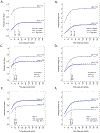Upper Limb Performance in Daily Life Approaches Plateau Around Three to Six Weeks Post-stroke
- PMID: 34510934
- PMCID: PMC8442937
- DOI: 10.1177/15459683211041302
Upper Limb Performance in Daily Life Approaches Plateau Around Three to Six Weeks Post-stroke
Abstract
Background. Wearable sensors allow for direct measurement of upper limb (UL) performance in daily life. Objective. To map the trajectory of UL performance and its relationships to other factors post-stroke. Methods. Participants (n = 67) with first stroke and UL paresis were assessed at 2, 4, 6, 8, 12, 16, 20, and 24 weeks after stroke. Assessments captured UL impairment (Fugl-Meyer), capacity for activity (Action Research Arm Test), and performance of activity in daily life (accelerometer variables of use ratio and hours of paretic limb activity), along with other potential modifying factors. We modeled individual trajectories of change for each measurement level and the moderating effects on UL performance trajectories. Results. Individual trajectories were best fit with a 3-parameter logistic model, capturing the rapid growth early after stroke within the longer data collection period. Plateaus (90% of asymptote) in impairment (bootstrap mean ± SE: 32 ± 4 days post-stroke) preceded those in capacity (41 ± 4 days). Plateau in performance, as measured by the use ratio (24 ± 5 days), tended to precede plateaus in impairment and capacity. Plateau in performance, as measured by hours of paretic activity (41 ± 6 days), occurred at a similar time to that of capacity and slightly lagged impairment. Modifiers of performance trajectories were capacity, concordance, UL rehabilitation, depressive symptomatology, and cognition. Conclusions. Upper limb performance in daily life approached plateau 3 to 6 weeks post-stroke. Individuals with stroke started to achieve a stable pattern of UL use in daily life early, often before neurological impairments and functional capacity started to stabilize.
Keywords: outcome assessment; recovery; rehabilitation; stroke; upper extremity.
Figures




References
-
- Jorgensen HS, Nakayama H, Raaschou HO, Vive-Larsen J, Stoier M, Olsen TS. Outcome and time course of recovery in stroke. Part II: Time course of recovery. The Copenhagen Stroke Study. Arch Phys Med Rehabil. May1995;76(5):406–12. - PubMed
-
- Duncan PW, Lai SM, Keighley J. Defining post-stroke recovery: implications for design and interpretation of drug trials. Neuropharmacology. March32000;39(5):835–41. - PubMed
-
- Kwakkel G, Kollen B, Lindeman E. Understanding the pattern of functional recovery after stroke: facts and theories. Restor Neurol Neurosci. 2004;22(3–5):281–99. - PubMed
MeSH terms
Grants and funding
LinkOut - more resources
Full Text Sources
Medical

